Job Analysis and Curriculum Design of South Korean Animal-Assisted Therapy Specialists Using DACUM
Abstract
Simple Summary
Abstract
1. Introduction
2. Materials and Methods
2.1. DACUM Commission
2.2. Process of DACUM Analysis
2.3. DACUM Analysis Verification Process
2.3.1. First Verification
2.3.2. Second Verification
2.4. Curriculum Derivation
3. Results
3.1. The Definition of an Animal-Assisted Therapy Specialist
3.2. Duties and Tasks
3.3. Knowledge, Skills, and Attitudes
3.4. Curriculum Design
3.5. Derivation of Curriculum Subjects
3.6. Curriculum Comparative Analysis
4. Discussion
5. Conclusions
Author Contributions
Funding
Institutional Review Board Statement
Informed Consent Statement
Data Availability Statement
Acknowledgments
Conflicts of Interest
References
- Fine, A.H.; Beck, A.M.; Ng, Z. The state of animal-assisted interventions: Addressing the contemporary issues that will shape the future. Int. J. Environ. Res. Public Health 2019, 16, 3997. [Google Scholar] [CrossRef] [PubMed]
- Levinson, B.M.; Mallon, G.P. Pet-Oriented Child Psychotherapy; Charles C Thomas Publishing Limited: Springfield, IL, USA, 1997. [Google Scholar]
- Fine, A.H. Handbook on Animal-Assisted Therapy: Foundations and Guidelines for Animal-Assisted Interventions; Academic Press: Cambridge, MA, USA, 2019. [Google Scholar]
- Townsend, L.; Gee, N.R. Recognizing and mitigating canine stress during animal assisted interventions. Vet. Sci. 2021, 8, 254. [Google Scholar] [CrossRef] [PubMed]
- London, M.D.; Mackenzie, L.; Lovarini, M.; Dickson, C.; Alvarez-Campos, A. Animal assisted therapy for children and adolescents with autism spectrum disorder: Parent perspectives. J. Autism Dev. Disord. 2020, 50, 4492–4503. [Google Scholar] [CrossRef] [PubMed]
- Wijker, C.; Leontjevas, R.; Spek, A.; Enders-Slegers, M.J. Effects of dog assisted therapy for adults with autism spectrum disorder: An exploratory randomized controlled trial. J. Autism Dev. Disord. 2020, 50, 2153–2163. [Google Scholar] [CrossRef] [PubMed]
- Wijker, C.; Leontjevas, R.; Spek, A.; Enders-Slegers, M.J. Process evaluation of animal-assisted therapy: Feasibility and relevance of a dog-assisted therapy program in adults with autism spectrum disorder. Animals 2019, 9, 1103. [Google Scholar] [CrossRef] [PubMed]
- Rodrigo-Claverol, M.; Malla-Clua, B.; Marquilles-Bonet, C.; Sol, J.; Jové-Naval, J.; Sole-Pujol, M.; Ortega-Bravo, M. Animal-assisted therapy improves communication and mobility among institutionalized people with cognitive impairment. Int. J. Environ. Res. Public Health 2020, 17, 5899. [Google Scholar] [CrossRef] [PubMed]
- Feng, Y.; Lin, Y.; Zhang, N.; Jiang, X.; Zhang, L. Effects of animal-assisted therapy on hospitalized children and teenagers: A systematic review and meta-analysis. J. Pediatr. Nurs. 2021, 60, 11–23. [Google Scholar] [CrossRef] [PubMed]
- Peluso, S.; De Rosa, A.; De Lucia, N.; Antenora, A.; Illario, M.; Esposito, M.; De Michele, G. Animal-assisted therapy in elderly patients: Evidence and controversies in dementia and psychiatric disorders and future perspectives in other neurological diseases. J. Geriatr. Psychiatry Neurol. 2018, 31, 149–157. [Google Scholar] [CrossRef]
- Klimova, B.; Toman, J.; Kuca, K. Effectiveness of the dog therapy for patients with dementia—A systematic review. BMC Psychiatry 2019, 19, 276. [Google Scholar] [CrossRef]
- Barker, S.B.; Dawson, K.S. The effects of animal-assisted therapy on anxiety ratings of hospitalized psychiatric patients. Psychiatr. Serv. 1998, 49, 797–801. [Google Scholar] [CrossRef]
- O’Haire, M.E. Animal-assisted intervention for autism spectrum disorder: A systematic literature review. J. Autism. Dev. Disord. 2013, 43, 1606–1622. [Google Scholar] [CrossRef] [PubMed]
- Ambrosi, C.; Zaiontz, C.; Peragine, G.; Sarchi, S.; Bona, F. Randomized controlled study on the effectiveness of animal-assisted therapy on depression, anxiety, and illness perception in institutionalized elderly. Psychogeriatrics 2019, 19, 55–64. [Google Scholar] [CrossRef]
- Veilleux, A. Benefits and challenges of animal-assisted therapy in older adults: A literature review. Nurs. Stand. 2021, 36, 28–33. [Google Scholar] [CrossRef]
- Germone, M.M.; Gabriels, R.L.; Guérin, N.A.; Pan, Z.; Banks, T.; O’Haire, M.E. Animal-assisted activity improves social behaviors in psychiatrically hospitalized youth with autism. Autism 2019, 23, 1740–1751. [Google Scholar] [CrossRef] [PubMed]
- Norton, R.E. DACUM Handbook. Leadership Training Series No. 67; Center on Education and Training for Employment, College of Education, The Ohio State University: Columbus, Ohio, USA, 1997. [Google Scholar]
- DeOnna, J. DACUM: A versatile competency-based framework for staff development. J. Nurs. Staff. Dev. 2002, 18, 5–11. [Google Scholar] [CrossRef]
- Oh, I.K.; Choi, J.I. Education Program. Development Methodology; Hakjisa: Seogyo-dong, Republic of Korea, 2005. [Google Scholar]
- Kim, S.-Y.; Park, S.-A.; Son, K.-C.; Lee, C. Horticultural therapy: Job analysis, performance evaluation, and educational needs. Korean J. Hortic. Sci. Technol. 2014, 32, 887–900. [Google Scholar] [CrossRef][Green Version]
- Yong, J.H.; Choi, H.S.; Jeong, W.M.; Lee, J.Y.; Park, H.Y.; Cho, B.Y.; Hong, S.P. Job analysis of Korean occupational therapists based on the DACUM method. J. Korean Soc. Occup. Ther. 2011, 19, 97–109. [Google Scholar]
- Kwon, H.; Song, Y.; Lee, K.; Hwang, R.; Lee, J.; Moon, J.; Kim, Y.; Kim, G.; Choi, Y. Job analysis of Korean physical therapists based on the DACUM method. J. Korean Phys. Ther. Sci. 2011, 18, 19–29. [Google Scholar]
- Lee, I.; Kim, S.; Bang, K.; Yi, Y.; Lee, S.; Kim, D.; Jang, S. Job analysis and curriculum development for forest healing instructor in charge of forest taegyo based on DACUM. J. Korean Inst. For. Recreat. 2020, 24, 37–46. [Google Scholar]
- Kim, J.; Lee, I.; Choo, J.; Noh, S.; Park, H.; Gweon, S.; Lee, k.; Kim, K. Job analysis of visiting nurses in the process of change using FGI and DACUM. J. Korean Acad. Community Health Nurs. 2022, 33, 13–31. [Google Scholar] [CrossRef]
- Kim, I.; Jo, N. Job analysis of school counselor using DACUM method. J. Korean Teach. Educ. 2010, 27, 97–115. [Google Scholar] [CrossRef]
- Kim, J.; Kim, K.J. The Subjects for Examination and Criteria for Preparation of Test Questions of the Engineer Plant Protection Qualifications Developed by DACUM. J Korean Soc. People Plants Environ. 2012, 15, 209–217. [Google Scholar]
- International Society for Animal Assisted Therapy. Draft Framework Curriculum. Available online: https://isaat.org/standards/ (accessed on 26 July 2023).
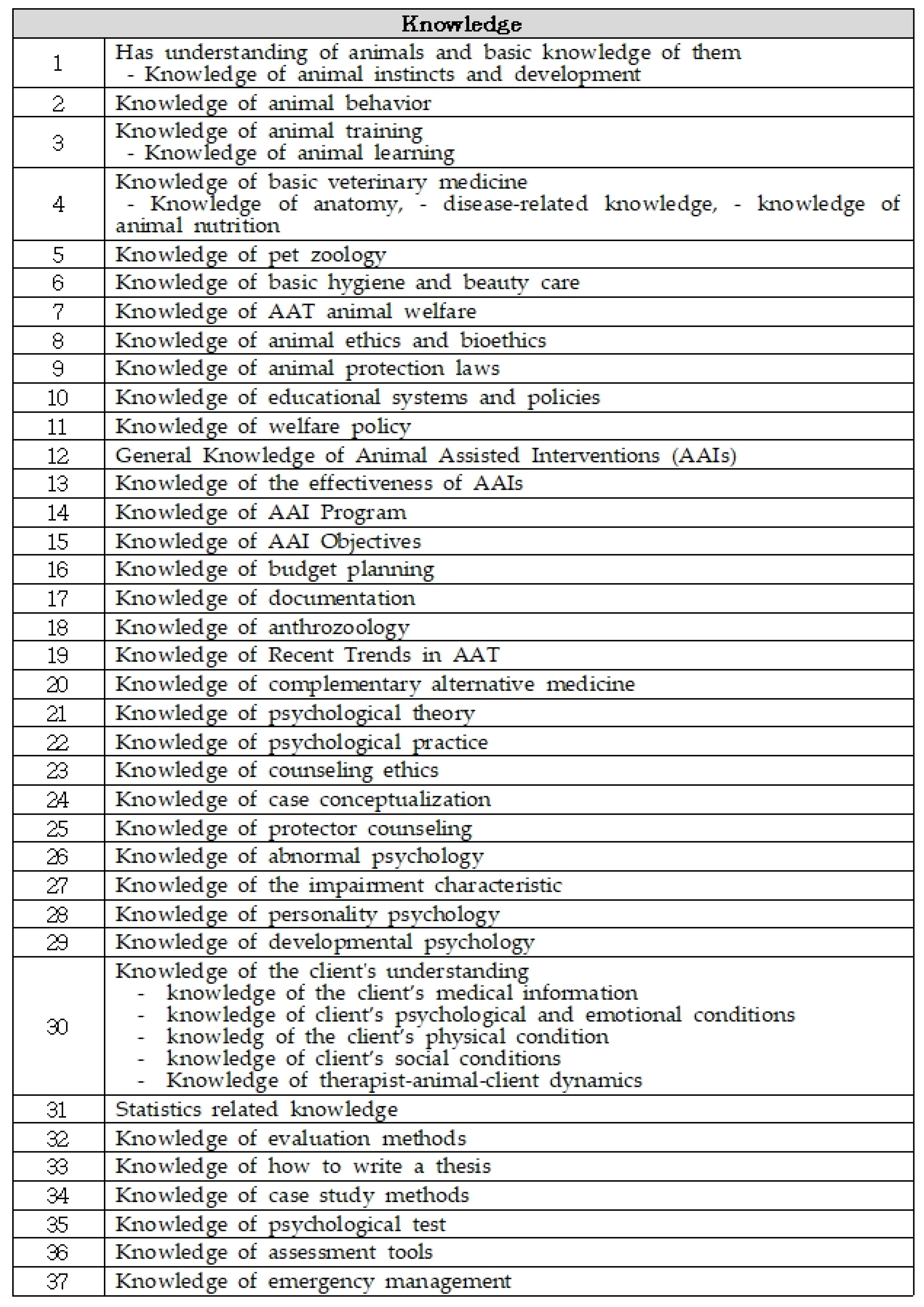
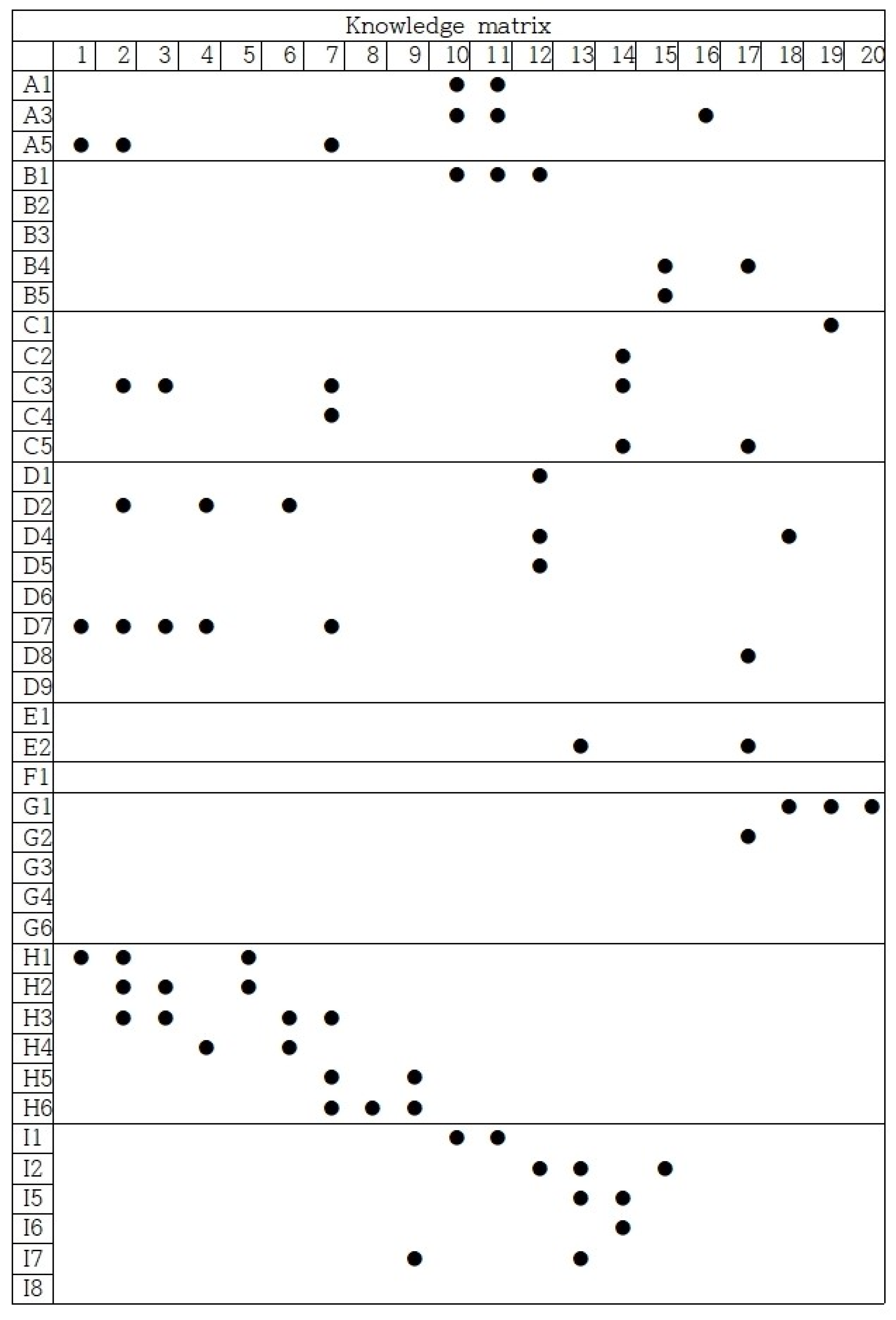
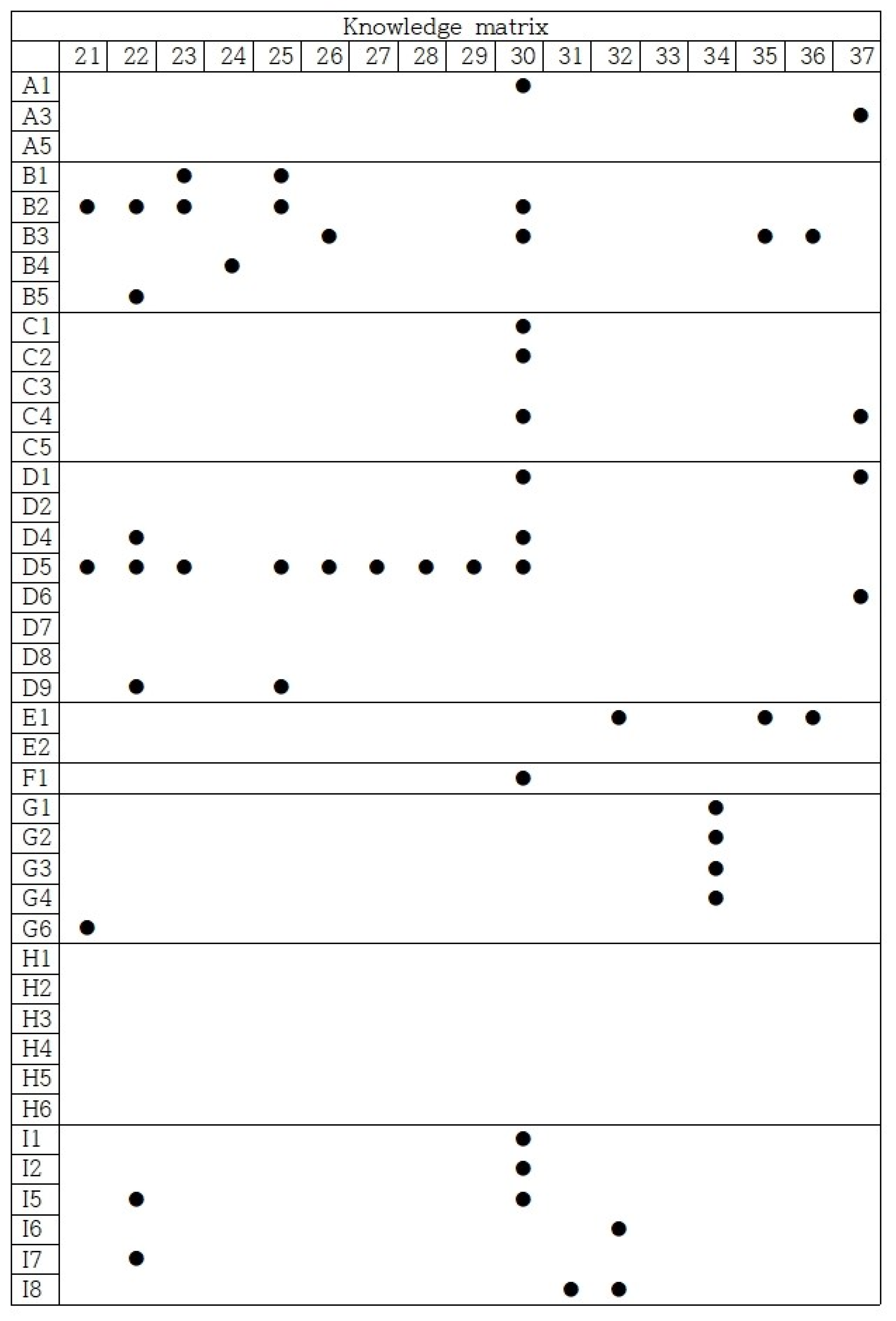
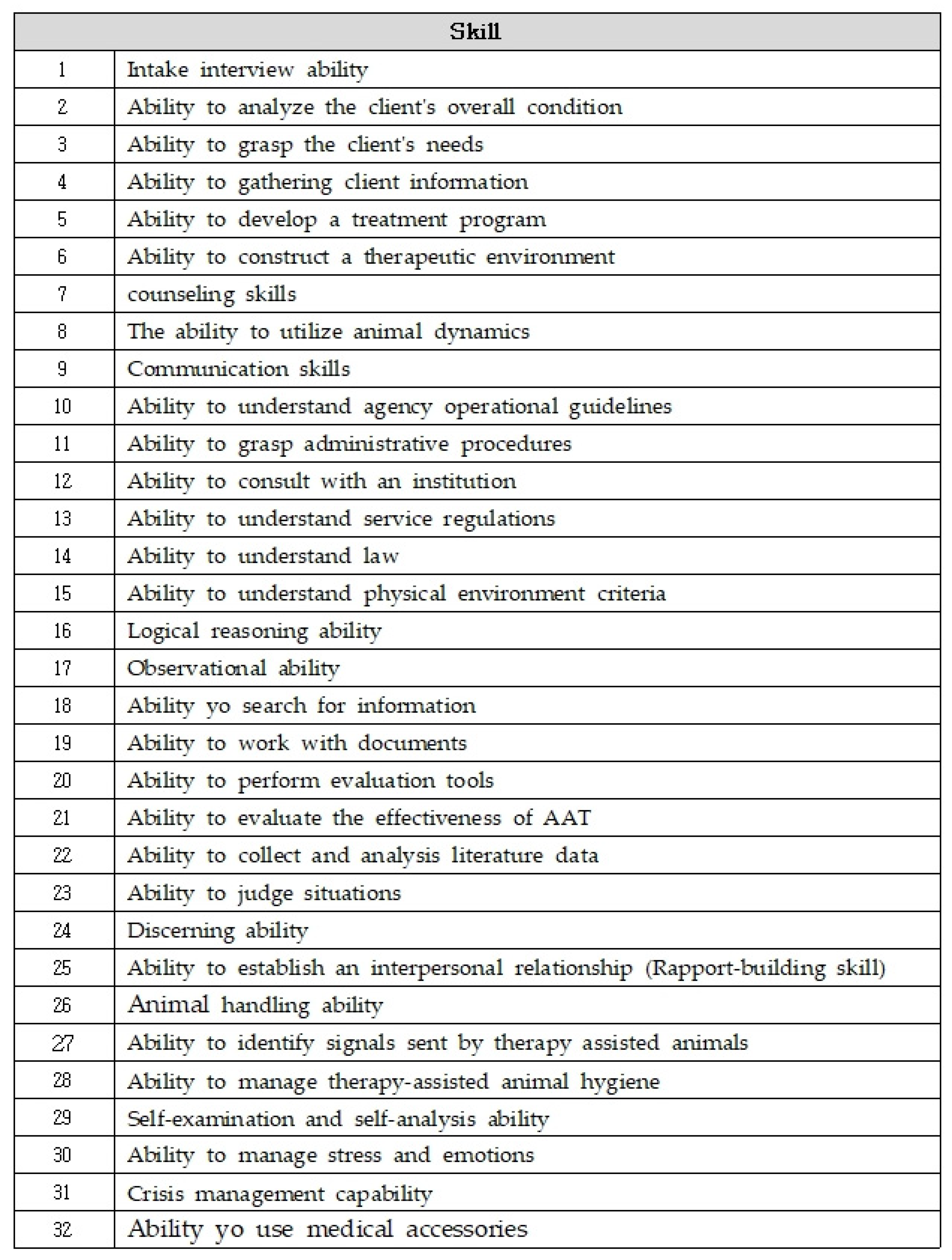
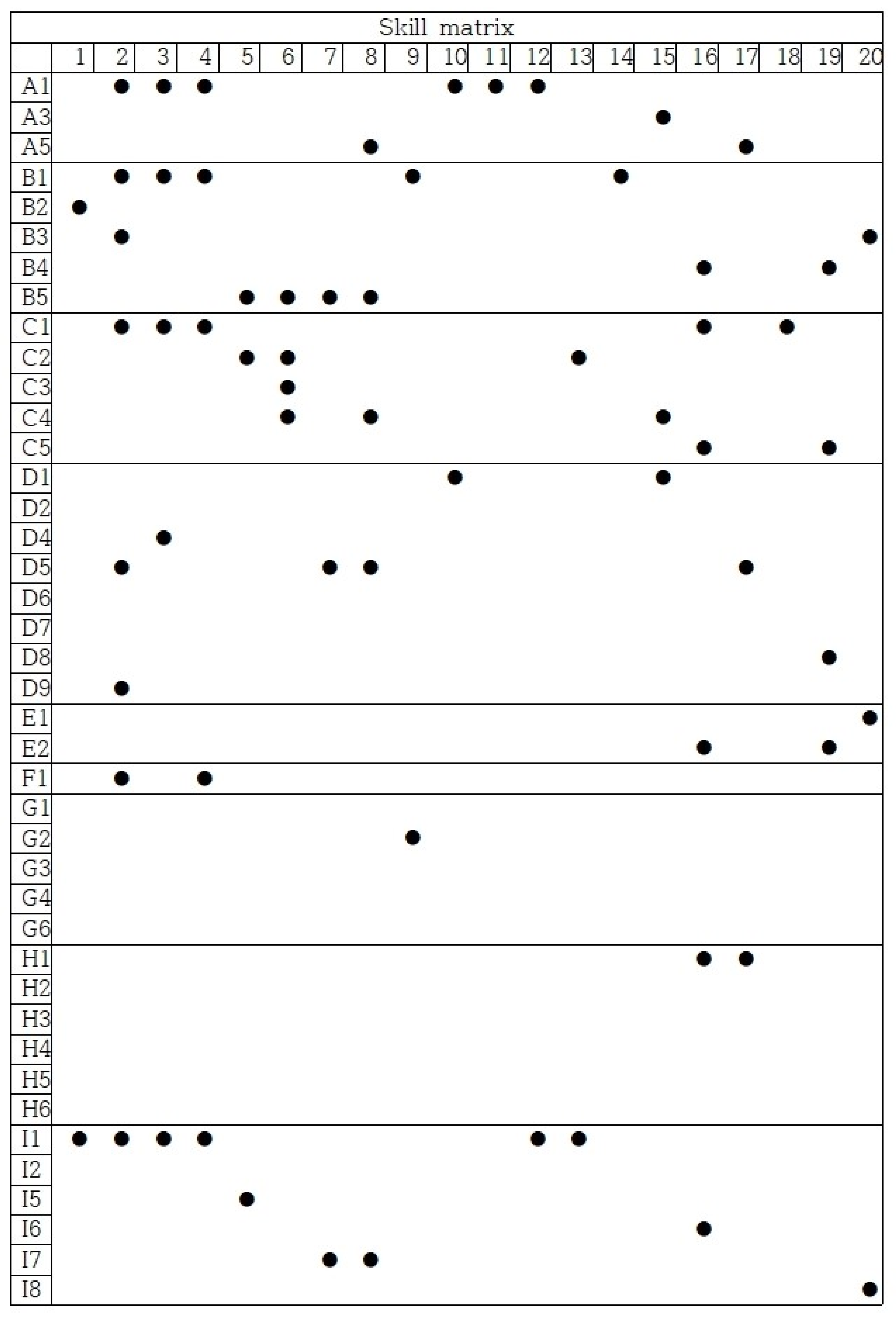
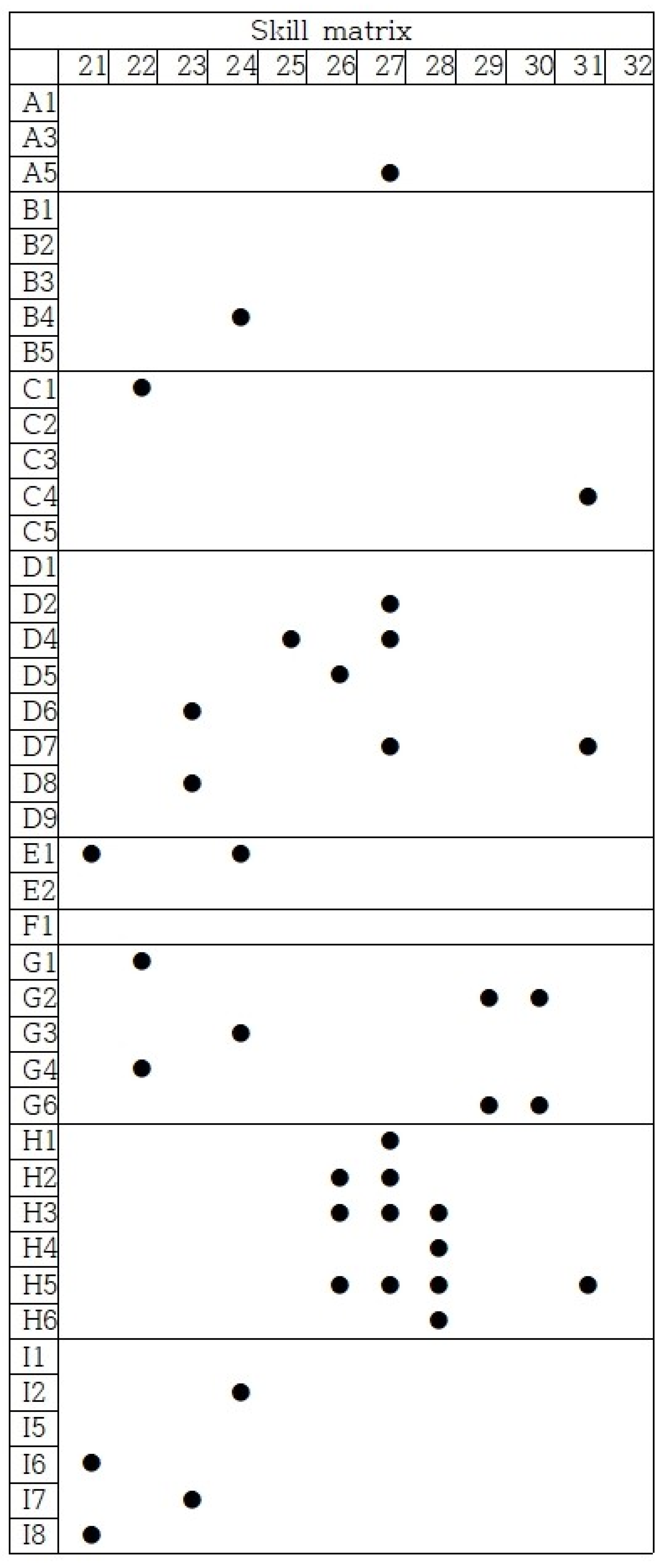
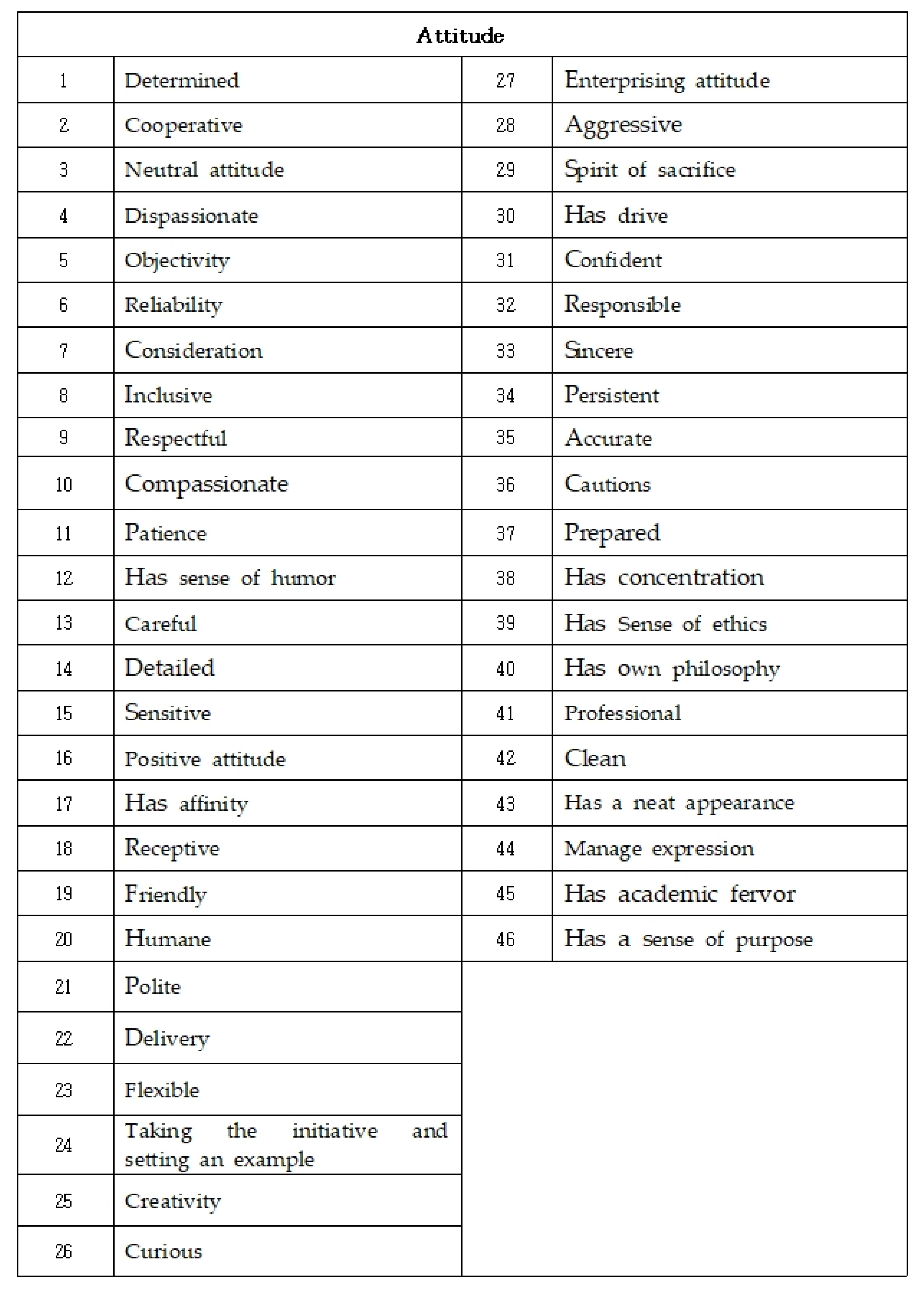
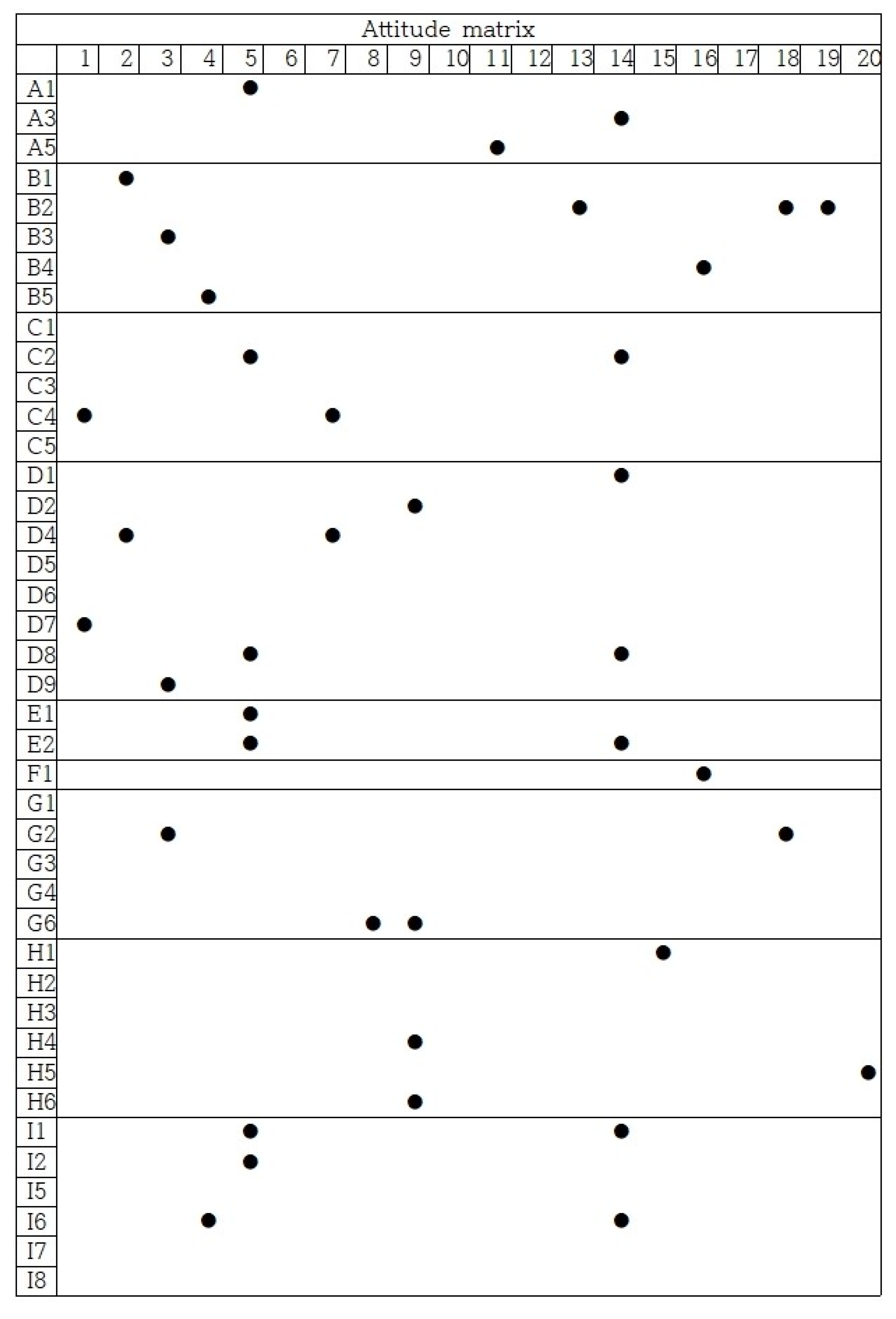
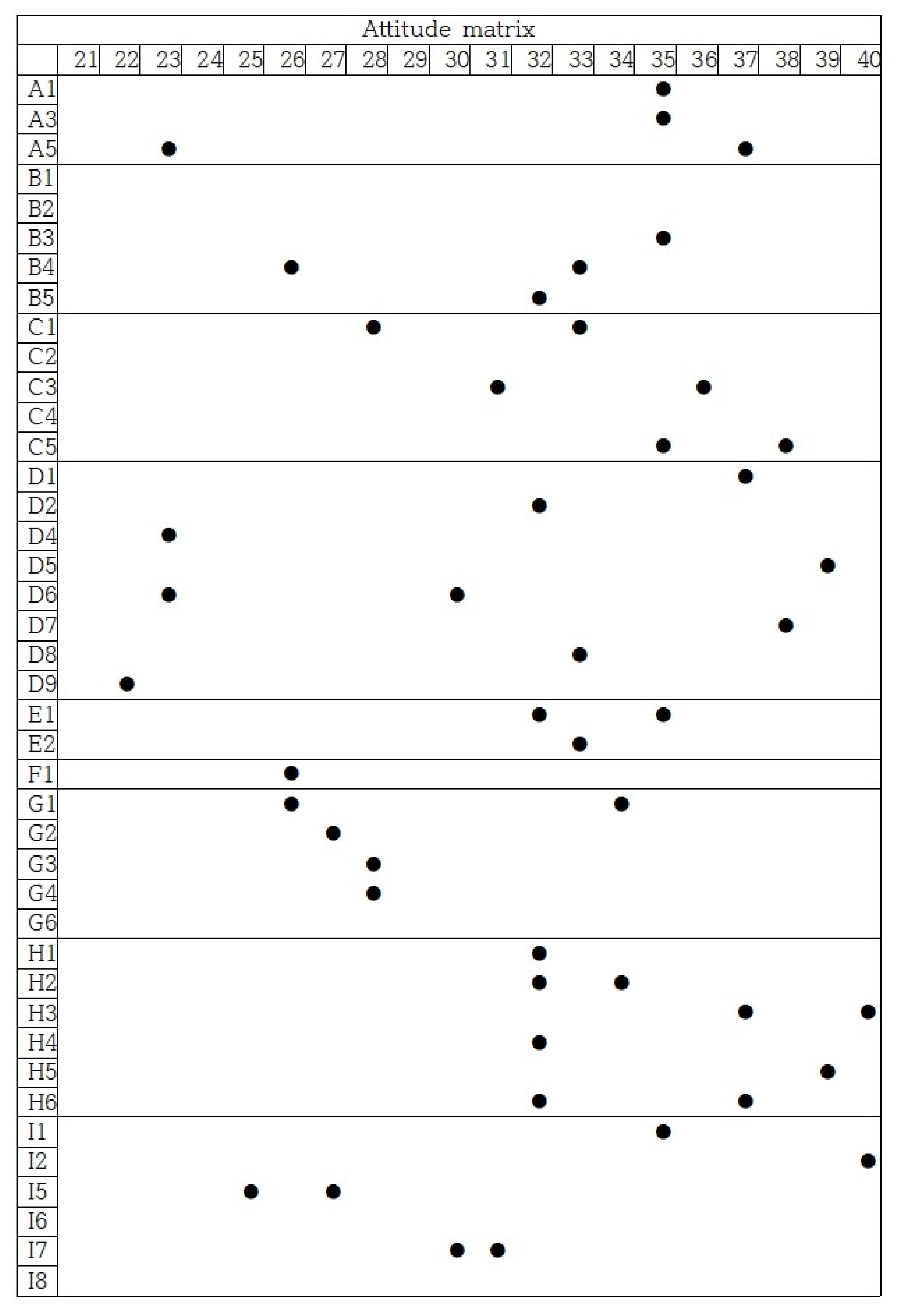

| Animal-Assisted Therapy Specialist Definition |
|---|
| Expert who supports psychological and emotional recovery, social adaptation, and development of the client through psychotherapeutic intervention using human–animal interactions. |
| A. Securing counseling resources | A-1 Identify service user types. | A-2 Discuss the site of the consultation. | A-3 Understand the field physical Environment. | A-4 Guide service users. | A-5 Adapt therapy animals to the consultation site. |
| B. Check the service users | B-1 Consult with agencies and individuals. | B-2 Perform intake interview. | B-3 Prepare psychological test. | B-4 Conceptualize case. | B-5 Create counseling strategy. |
| C. Program design | C-1 Investigate the right program for the counselee. | C-2 Select the appropriate program format for the counselee. | C-3 Select a therapy animal and determine its duties. | C-4 Set up the physical environment in consideration of the counselee and the therapy animal. | C-5 Design the appropriate program for counselee. |
| D. Progress consultation | D-1 Check the consultation environment. | D-2 Check therapy animal’s condition before session. | D-3 Obtain consent after explanation to the service user. | D-4 Form relationship between the client, AAT specialist, and animal. | D-5 Perform psychotherapy intervention. |
| D-6 Provide a physical environment as the situation changes. | D-7 Check for and take action on therapy animal stress signals. | D-8 Document the session process. | D-9 Consult on closure later in the session. | ||
| E. Evaluation of counseling | E-1 Evaluate of consultation results. | E-2 Write the results report. | |||
| F. Follow-up management | F-1 Identify the current state of affairs. | F-2 Decide whether to consult further. | F-3 Document the follow-up results. | ||
| G. Development of AAT specialist competency | G-1 Learn up-to-date information on relevant areas. | G-2 Perform supervision. | G-3 Participate in case meetings. | G-4 Attend an academic meeting on animal-assisted interventions. | G-5 Publish the results of animal-assisted intervention cases in journals. |
| G-6 Develop AAT specialist self-awareness and perform self-care | G-7 Perform self-promotion and marketing. | ||||
| H. Therapy-assisting animal care | H-1 Identify the characteristics of therapy-assisting animals. | H-2 Educate therapy-assisting animals. | H-3 Become certified as a therapy-assisting animal. | H-4 Perform veterinary management of therapy-assisting animals. | H-5 Ensure animal welfare in every process. |
| H-6 Establish a management plan for the retirement of therapy-assisting animals. | |||||
| I. Development of new programs | I-1 Perform service user analysis. | I-2 Set program objectives. | I-3 Collect the preceding programs. | I-4 Analyze the preceding programs. | I-5 Develop programs that are appropriate for service user. |
| I-6 Check program validity. | I-7 Execute and apply the program. | I-8 Analyze program results. | I-9 Check the significance of the program. | I-10 Modify the program. | |
| I-11 Review the precautions. | I-12 Document the development plan. |
| Knowledge |
|---|
Has understanding of animals and basic knowledge of them
Knowledge of basic hygiene and beauty care |
| Knowledge of AAT animal welfare Knowledge of animal ethics and bioethics Knowledge of animal protection laws |
| Knowledge of educational systems and policies Knowledge of welfare policy General knowledge of animal-assisted interventions (AAIs) Knowledge of the effectiveness of AAIs Knowledge of AAI programs Knowledge of AAI objectives Knowledge of budget planning Knowledge of documentation Knowledge of anthrozoology Knowledge of recent trends in AAT Knowledge of complementary alternative medicine |
| Knowledge of psychological theory Knowledge of psychological practice Knowledge of counseling ethics Knowledge of case conceptualization Knowledge of protector counseling |
| Knowledge of abnormal psychology Knowledge of impairment characteristics Knowledge of personality psychology |
| Knowledge of developmental psychology |
Knowledge of the client’s understanding
|
| Statistics-related knowledge Knowledge of evaluation methods Knowledge of how to write a thesis Knowledge of case study methods |
| Knowledge of psychological test Knowledge of assessment tools |
| Knowledge of emergency management |
| Skills |
| Intake interview ability Ability to analyze the client’s overall condition Ability to grasp the client’s needs Ability to gathering client information Ability to develop a treatment program Ability to construct a therapeutic environment |
| Counseling skills The ability to utilize animal dynamics Communication skills |
| Ability to understand agency operational guidelines Ability to grasp administrative procedures Ability to consult with an institution Ability to understand service regulations Ability to understand laws Ability to understand physical environment criteria |
| Logical reasoning ability Observational ability |
| Ability to search for information |
| Ability to work with documents Ability to use evaluation tools Ability to evaluate the effectiveness of AAT Ability to collect and analyze literature data |
| Ability to judge situations Discerning ability |
| Ability to establish an interpersonal relationship (rapport-building skill) |
| Animal-handling ability Ability to identify signals sent by therapy-assisting animals Ability to manage therapy-assisting animal hygiene |
| Self-examination and self-analysis ability Ability to manage stress and emotions |
| Crisis management capability |
| Ability to use medical accessories |
| Attitudes |
| Determined, cooperative |
| Neutral attitude, Dispassionate, Objective, Reliable |
| Considerate, Inclusive, Respectful, Compassionate, Patient, Has sense of humor |
| Careful, Detailed, Sensitive |
| Positive attitude, Has affinity, Receptive, Friendly, Humane, Polite |
| Flexible, Takes the initiative and sets an example |
| Creative, Curious |
| Enterprising attitude, Aggressive, Spirit of sacrifice, Has drive |
| Confident, Responsible, Sincere, Persistent, Accurate, Cautious, Prepared, Has concentration |
| Has sense of ethics, Has own philosophy, Professional, Clean, Has a neat appearance, Manages expression, Has academic fervor, Has a sense of purpose |
| Core Course | Knowledge (K) Skill (S) Attitude (A) | Subject | |
|---|---|---|---|
| A1 | K | 10, 11, 30 | Understanding Counselee |
| S | 2, 3, 4, 10, 11, 12 | ||
| A | 5, 35 | ||
| A3 | K | 10, 11, 16, 37 | Clinical Practice |
| S | 15 | ||
| A | 14, 35 | ||
| A5 | K | 1, 2, 7 | Therapy-Assisting Animal Management |
| S | 8, 17, 27 | ||
| A | 11, 23, 37 | ||
| B1 | K | 10, 11, 12, 23, 25 | Understanding Counselee |
| S | 2, 3, 4, 9, 14 | ||
| A | 2, 41 | ||
| B2 | K | 21, 22, 23, 25, 30 | Case Conceptualization |
| S | 1 | ||
| A | 13, 18, 19 | ||
| B3 | K | 26, 30, 35, 36 | Psychological Test and Evaluation |
| S | 2, 20 | ||
| A | 3, 35, 41 | ||
| B4 | K | 5, 17, 24 | Case Conceptualization |
| S | 16, 19, 24 | ||
| A | 16, 26, 33 | ||
| B5 | K | 15, 22 | Case Conceptualization |
| S | 5, 6, 7, 8 | ||
| A | 4, 32, 43 | ||
| C1 | K | 19, 30 | Program Development |
| S | 2, 3, 4, 16, 18, 22 | ||
| A | 28, 33 | ||
| C2 | K | 14, 30 | Program Development |
| S | 5, 6, 13 | ||
| A | 5, 14 | ||
| C3 | K | 2, 3, 7, 14 | Therapy-Assisting Animal Management |
| S | 6 | ||
| A | 31, 36 | ||
| C4 | K | 7, 30, 37 | Clinical Practice |
| S | 6, 8, 15, 31 | ||
| A | 1, 7 | ||
| C5 | K | 14, 17 | Program Development |
| S | 16, 19 | ||
| A | 28, 35 | ||
| D1 | K | 12, 30, 37 | Clinical Practice |
| S | 10, 15 | ||
| A | 14, 37 | ||
| D2 | K | 2, 4, 6 | Therapy-Assisting Animal Management |
| S | 27 | ||
| A | 9, 32 | ||
| D4 | K | 12, 18, 22, 30 | Introduction to Animal-Assisted Interventions |
| S | 3, 25, 27 | ||
| A | 2, 7, 23 | ||
| D5 | K | 12, 21, 22, 23, 25, 26, 27, 28, 29, 30 | Counseling and Understanding Psychology |
| S | 2, 7, 8, 17, 26 | ||
| A | 38, 41 | ||
| D6 | K | 37 | Clinical Practice |
| S | 23 | ||
| A | 23, 30 | ||
| D7 | K | 1, 2, 3, 4, 7 | Therapy-Assisting Animal Management |
| S | 27, 31 | ||
| A | 1, 38 | ||
| D8 | K | 17 | Program Development |
| S | 19, 23 | ||
| A | 5, 14, 33 | ||
| D9 | K | 22, 25 | Counseling and Understanding Psychology |
| S | 2 | ||
| A | 3, 22 | ||
| E1 | K | 32, 35, 36 | Psychological Test and Evaluation |
| S | 20, 21, 24 | ||
| A | 5, 32, 35 | ||
| E2 | K | 13, 17 | Evaluation Analysis and Reporting |
| S | 16, 19 | ||
| A | 5, 14, 33 | ||
| F1 | K | 30 | Counseling and Understanding Psychology |
| S | 2, 4 | ||
| A | 16, 26 | ||
| G1 | K | 18, 19, 20, 34 | Case Research and Practice |
| S | 22 | ||
| A | 26, 34, 45 | ||
| G2 | K | 17, 34 | Case Guidance and Management |
| S | 9, 29, 30 | ||
| A | 3, 18, 27 | ||
| G3 | K | 34 | Case Research and Practice |
| S | 24 | ||
| A | 28, 45 | ||
| G4 | K | 34 | Case Research and Practice |
| S | 22 | ||
| A | 28, 45 | ||
| G6 | K | 21 | Case Guidance and Management |
| S | 29, 30 | ||
| A | 8, 9 | ||
| H1 | K | 1, 2, 5 | Training and Behavior |
| S | 16, 17, 27 | ||
| A | 15, 32 | ||
| H2 | K | 2, 3, 5 | Training and Behavior |
| S | 26, 27 | ||
| A | 32, 34 | ||
| H3 | K | 2, 3, 6, 7 | Training and Behavior |
| S | 26, 27, 28 | ||
| A | 37, 41 | ||
| H4 | K | 4, 6 | Therapy-Assisting Animal Management |
| S | 28 | ||
| A | 9, 32 | ||
| H5 | K | 7, 9 | Animal Welfare |
| S | 27, 28, 29, 31 | ||
| A | 20, 39 | ||
| H6 | K | 7, 8, 9 | Therapy-Assisting Animal Management |
| S | 28 | ||
| A | 9, 32, 37 | ||
| I1 | K | 10, 11, 30 | Understanding Counselee |
| S | 1, 2, 3, 4, 12, 13 | ||
| A | 5, 14, 35 | ||
| I2 | K | 12, 13, 15, 30 | Program Development |
| S | 24 | ||
| A | 5, 40 | ||
| I5 | K | 13, 14, 22, 30 | Program Development |
| S | 5 | ||
| A | 25, 27 | ||
| I6 | K | 14, 32 | Program Development |
| S | 16, 21 | ||
| A | 4, 14 | ||
| I7 | K | 9, 13, 22 | Program Development |
| S | 7, 8, 23 | ||
| A | 30, 31, 46 | ||
| I8 | K | 31, 32 | Program Development |
| S | 20, 21 | ||
| A | 41, 45 | ||
| No. | Course | Main Content |
|---|---|---|
| 1 | Understanding Counselee | Abnormal Psychology |
| Developmental Psychology | ||
| Understanding Disabilities | ||
| 2 | Clinical Practice | Animal-Assisted Intervention Clinical Practice |
| 3 | Therapy-Assisting Animal Management | Veterinary Management of Therapy Animals |
| Stress Management for Therapy-Assisting Animal | ||
| 4 | Case Conceptualization | Understanding Case Conceptualization |
| Case Conceptualization Practice | ||
| 5 | Psychological Test and Evaluation | Understanding and Methods of Psychological Test |
| Measurement and Evaluation of Psychological Test | ||
| 6 | Program Development | Animal-Assisted Intervention Program Planning |
| Execution of Animal-Assisted Intervention Program | ||
| Evaluation of Animal-Assisted Intervention Program | ||
| 7 | Introduction to Animal-assisted Intervention | Concept and Subcategories of Animal-Assisted Intervention |
| Principles and Effectiveness of Animal-Assisted Intervention | ||
| Understanding the Relationship between Humans and Animals | ||
| Recent Research Trends in Animal-Assisted Interventions | ||
| Considerations for Implementing Animal-Assisted Interventions | ||
| 8 | Counseling and Understanding Psychology | Group Counseling |
| Personal Counseling | ||
| Counseling Theory and Practice | ||
| 9 | Evaluation Analysis and Reporting | Evaluation and Analysis Methods for Animal-Assisted Interventions |
| Research Methodology | ||
| 10 | Case Research and Practice | Analysis Techniques for Understanding Cases |
| 11 | Case Guidance and Management | Case Presentation |
| Supervision | ||
| Counselor education analysis | ||
| 12 | Training and Behavior | Animal Behavior |
| Training and Selection of Therapy-Assisting Animals | ||
| 13 | Animal Welfare | Welfare of Therapy-Assisting Animals |
| Animal Welfare |
| Course | Main Content | EQF | |
|---|---|---|---|
| Understanding Counselee | Abnormal Psychology | Educational, psychological, rehabilitative, and socially integrative services with animals for children, adolescents, adults, or elderly people with cognitive, social, emotional, and physical disabilities, behavioral disorders, general remedial focus and require competence enhancement. | Basic psychopathology |
| Developmental Psychology | Fundamentals of gerontology and geriatrics | ||
| Understanding Disabilities | Pedagogy specialty | ||
| Clinical Practice | Animal-Assisted Intervention Clinical Practice | ||
| Therapy assisted animal Management | Veterinary Management of Therapy Animals | Animal health/first aid for animals | |
| Stress Management for Therapy-Assisting Animals | Ethology and veterinary medicine—Relationship design | ||
| Case Conceptualization | Understanding Case Conceptualization | ||
| Case Conceptualization Practice | |||
| Psychological Test and Evaluation | Understanding and Methods of Psychological Test | ||
| Measurement and Evaluation of Psychological Test | |||
| Program Development | Animal-Assisted Intervention Program Planning | Resource-oriented models | Planning and organization in the AAI environment (organizational and project management, intervention planning) |
| Execution of Animal-Assisted Intervention Program | |||
| Evaluation of Animal-Assisted Intervention Program | |||
| Introduction to Animal-assisted Intervention | Concept and Subcategories of Animal-Assisted Interventions | Explanatory models for AAI Definition of AAI | |
| Principles and Effectiveness of Animal-Assisted Interventions | Methods for AAIs Relationships and process design in AAIs | ||
| Understanding the Relationship between Humans and Animals | Models of human–animal relationships | ||
| Recent Research Trends in Animal-Assisted Interventions | |||
| Considerations for Implementing Animal-Assisted Interventions | Legal requirements and aspects for AAIs Hygiene management Risk management Human first aid | ||
| Counseling and Understanding Psychology | Group Counseling | ||
| Personal Counseling | |||
| Counseling Theory and Practice | Psychological foundations for AAIs | ||
| Evaluation Analysis and Reporting | Evaluation and Analysis Methods for Animal-Assisted Interventions | Scientific studies on the effectiveness of AAIs | |
| Research Methodology | Basics of scientific work | ||
| Case Research and Practice | Analysis Techniques for Understanding Cases | Best practice examples of AAIs from Germany and abroad | |
| Case Guidance and Management | Case Presentation | Presentation and communication forms | |
| Supervision | |||
| Counselor Education Analysis | Mental hygiene for the helping professions | ||
| Training and Behavior | Animal Behavior | Ethological basics Animal learning behavior | |
| Training and Selection of Therapy-Assisting Animals | Training of animals for use in AAIs | ||
| Animal Welfare | Welfare of Therapy-Assisting Animals | Ethics of human–animal relationships | |
| Animal Welfare | |||
Disclaimer/Publisher’s Note: The statements, opinions and data contained in all publications are solely those of the individual author(s) and contributor(s) and not of MDPI and/or the editor(s). MDPI and/or the editor(s) disclaim responsibility for any injury to people or property resulting from any ideas, methods, instructions or products referred to in the content. |
© 2024 by the authors. Licensee MDPI, Basel, Switzerland. This article is an open access article distributed under the terms and conditions of the Creative Commons Attribution (CC BY) license (https://creativecommons.org/licenses/by/4.0/).
Share and Cite
Choi, S.J.; Han, J.S. Job Analysis and Curriculum Design of South Korean Animal-Assisted Therapy Specialists Using DACUM. Animals 2024, 14, 1943. https://doi.org/10.3390/ani14131943
Choi SJ, Han JS. Job Analysis and Curriculum Design of South Korean Animal-Assisted Therapy Specialists Using DACUM. Animals. 2024; 14(13):1943. https://doi.org/10.3390/ani14131943
Chicago/Turabian StyleChoi, Soo Jeong, and Jin Soo Han. 2024. "Job Analysis and Curriculum Design of South Korean Animal-Assisted Therapy Specialists Using DACUM" Animals 14, no. 13: 1943. https://doi.org/10.3390/ani14131943
APA StyleChoi, S. J., & Han, J. S. (2024). Job Analysis and Curriculum Design of South Korean Animal-Assisted Therapy Specialists Using DACUM. Animals, 14(13), 1943. https://doi.org/10.3390/ani14131943






